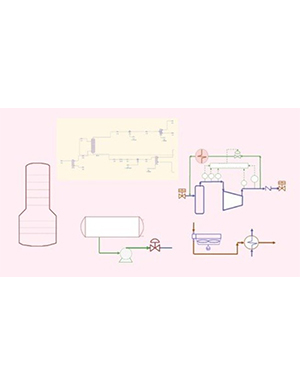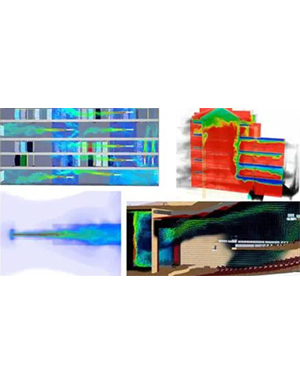Download Oil and Gas Separation Design Course
Oil and Gas Separation Process Design Course by udemy download for Vertical and Horizontal Separator Sizing with API 12J Considerations. The Oil and Gas Separation Design training course is designed to provide the harmony of theoretical knowledge behind oil and gas separation principles and practical guidelines (specifically, API 12J) for vertical and horizontal separator design.
Oil and gas separation is a common technique in upstream oil and gas wells, where crude oil and natural gas are often found in the same well. Oil and natural gas have different density levels, so mixing them together can cause problems down the road. Oil and gas separation allows for these two products to be distinct from one another. Process equipment companies in the oil and natural gas industry use a number of equipment units designed to separate, or “separate,” crude oil from fluids involved in the production of oil. Oil and gas separation is done by physical means, not chemical means.
The training course goes over the following topics, in 40 lectures and 5 practice sessions with 4 hours of video training material:
- Principles of Separation Theory
- Separation Mechanisms
- Phase Diagrams
- Vapor-Liquid Equilibrium Theory and Calculations
- Raoult’s Law and Antonie Equation
- Bubble and Dew Point Calculations
- Flash Calculations
- Classification of Oil and Gas Separators
- Internal Structure of Separators
- Separator Internals (Inlet Device, Mist Extractor, Vortex Breaker, etc.)
- Separator Design (API 12J Process Considerations)
- Vertical Separator Design
- Horizontal Separator Design
- Common Separator Design Errors
- Operating Challenges in Gravity Separation
What you’ll learn
- Principles of Separation Theory
- Separation Mechanisms
- Phase Diagrams
- Vapor-Liquid Equilibrium Theory and Calculations
- Raoult’s Law and Antonie Equation
- Bubble and Dew Point Calculations
- Flash Calculations
- Classification of Gravity Separators
- Internal Structure of Separators
- Separator Internals (Inlet Device, Mist Extractor, Vortex Breaker, etc.)
- Separator Design (API 12J Process Considerations)
- Vertical Separator Design
- Horizontal Separator Design
- Common Separator Design Errors
- Operating Challenges in Gravity Separation
Who this course is for
- Engineers working with Oil and Gas Separators
- Process Engineers
- Chemical Engineers
- Chemical Process Engineering Graduates or Undergraduates
- Any Discipline Engineers Aiming to Learn Essentials of Vertical and Horizontal Separator Sizing
Course content
- Section 1: Introduction to Separation Principles
- Lecture 1 Importance of Oil and Gas Separation
- Lecture 2 Separation Mechanisms
- Lecture 3 Essential Parameters of Oil and Gas Separation
- Section 2: Phase Diagrams and Vapor-Liquid Equilibrium
- Lecture 4 Fundamentals of Phase Diagrams – Part I
- Lecture 5 Fundamentals of Phase Diagrams – Part II
- Lecture 6 Vapor-Liquid Equilibrium Theory
- Lecture 7 Raoult’s Law and Antonie Equation
- Lecture 8 Bubble Point and Dew Point Pressure – Theory
- Lecture 9 Practice Session 1: Bubble Point Pressure Calculation
- Lecture 10 Practice Session 2: Dew Point Pressure Calculation
- Section 3: Flash Calculations in Oil and Gas Separation
- Lecture 11 Importance of Flash Calculations
- Lecture 12 Joule Thomson Effect in Flash Conditions
- Lecture 13 Flash Calculation Procedure
- Lecture 14 Practice Session 3: HP Well Flash Calculation – Part I
- Lecture 15 Practice Session 3: HP Well Flash Calculation – Part II
- Section 4: Classification of Separators and Separator Internal Design
- Lecture 16 Classification of Separators – Part I
- Lecture 17 Classification of Separators – Part II
- Lecture 18 Internal Structure of Oil and Gas Separators
- Lecture 19 Inlet Device: Plate Diverter
- Lecture 20 Inlet Device: Half-Open Pipe
- Lecture 21 Inlet Device: Vane Distributor and Others
- Lecture 22 Demister and Vortex Breaker
- Lecture 23 Importance of Level and Pressure Control for Separator
- Section 5: Separator Design Basics – API 12J Considerations
- Lecture 24 Separator Design Basics – Introduction
- Lecture 25 Separator Design – API 12J/Process Considerations – Part I
- Lecture 26 Separator Design – API 12J/Process Considerations – Part II
- Lecture 27 Separator Design – API 12J/Process Considerations – Part III
- Lecture 28 Separator Design – API 12J/Corrosion Guidelines
- Lecture 29 Separator Design Deliverables
- Section 6: Vertical and Horizontal Separator Design
- Lecture 30 Practice Session 4: Vertical Separator Sizing – Part I
- Lecture 31 Practice Session 4: Vertical Separator Sizing – Part II
- Lecture 32 Practice Session 4: Vertical Separator Sizing – Part III
- Lecture 33 Practice Session 4: Vertical Separator Sizing – Part IV
- Lecture 34 Practice Session 4: Vertical Separator Sizing – Part V
- Lecture 35 Practice Session 4: Vertical Separator Sizing – Part VI
- Lecture 36 Practice Session 4: Vertical Separator Sizing – Part VII
- Lecture 37 Practice Session 5: Horizontal Separator Sizing – Part I
- Lecture 38 Practice Session 5: Horizontal Separator Sizing – Part II
- Lecture 39 Common Separator Design Errors
- Lecture 40 Operating Challenges in Oil and Gas Separation
Course details
- Video quality: MP4 | Video: h264, 1280 × 720
- Audio quality: Audio: AAC, 44.1 KHz, 2 Ch
- Video duration: 4h 7m
- Number of lessons: 40 lectures
- Language: English
- Compressed file size: 1.65 GB
 Discount code: BlackFriday Sale ends in
Discount code: BlackFriday Sale ends in 



